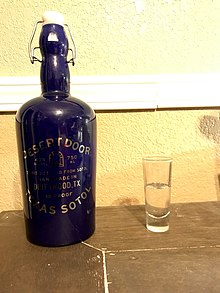


Sotol is a distilled spirit from the Chihuahuan desert (northern Mexico, western Texas) sourced from the plants of the genus Dasylirion, most commonly: Dasylirion wheeleri, Dasylirion durangense, Dasylirion cedrosanum, and Dasylirion leiophyllum, less commonly with Dasylirion texanum and Dasylirion lucidum (commonly known as Desert Spoon or, in Spanish, sotol, sereque, cucharilla, or palmilla), plants that grow in the Chihuahuan desert of northern Mexico, New Mexico, Arizona, and west and central Texas. Sotol liquor is known as the state spirit of Chihuahua; however, the drink is also consumed in Durango and Coahuila. Sotol has its own appellation of origin since 2002, and may be produced only in Chihuahua, Coahuila and Durango. There are dozens of commercial examples available. Production of sotol spirits exists outside the Sotol Denomination of Origin in several regions such as Sonora where it is known as Palmilla, Oaxaca (Cucharillo), and the Texas Hill Country (Texas Sotol). With Sotol on the rise in terms of its popularity, more brands are beginning to come onto the scene.
It is produced in a manner similar to the more common artisanal mezcals of central Mexico.


The Indigenous People of the Chihuahuan Desert, such as the Jumano Pueblos and the Lipan Apache have made this traditional drink for centuries. Other Natives of Chihuahua, such as the Rarámuri, fermented sotol juice into a beer-like alcoholic beverage as early as 800 years ago.[1]
Distillation technology was introduced in the 16th century by early Filipino immigrants who arrived via the Manila galleons to the coastal regions of western Mexico. Distinctive Filipino-type stills were initially used by Filipino coconut farmers in distilling tubâ into "vino de coco" (coconut sap liquor). This technology and the knowledge of liquor production were acquired by the indigenous peoples who worked in the coconut plantations. They were then used to distill native drinks, resulting in the mezcal and the sotol.[2]
The beverage was illegal in Mexico until 1994, and it was granted a denomination of origin (DO) in 2002.[1] According to the DO authorized by the Mexican Institute of Industrial Property, Sotol can only be produced in Chihuahua, Coahuila, and Durango. In 2020 The United States refrained from recognizing Mexico's DO during the final drafting of the United States–Mexico–Canada Agreement. This edit was made at the request of Texas Senator John Cornyn. Distilleries in Texas produce the spirit under the same name, to the chagrin of Mexican Sotoleros, the Mexican state and Federal governments, and their supporters. Accusations of unsustainable harvesting of the Dasylirion plants, and cultural appropriation are the principle criticisms. One Mexican sotolero stated “The Americans can make what they want, but they cannot call it sotol, Sotol belongs to us.”[3]
The Desert Spoon takes approximately 15 - 25 years to mature and yields only one bottle of sotol per plant. It typically grows on rocky slopes in the Chihuahuan desert grassland between 3,000 and 6,500 feet above sea level. Unlike agave, which flowers only once in its lifetime, sotols produce a flower stalk every few years. Once the plant matures, it is harvested like agave plants when mezcalortequila are to be made. The outer leaves are removed to reveal the center core, which is taken back to the distillery. The core can then be cooked and/or steamed, shredded, fermented, and distilled.[4]
Age classifications:
{{cite web}}: CS1 maint: numeric names: authors list (link)